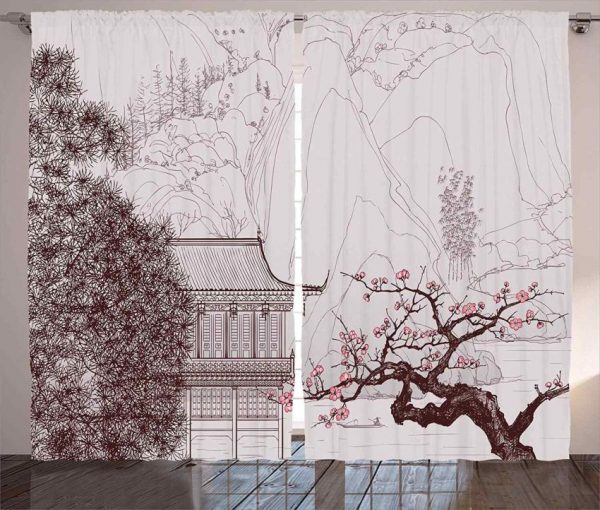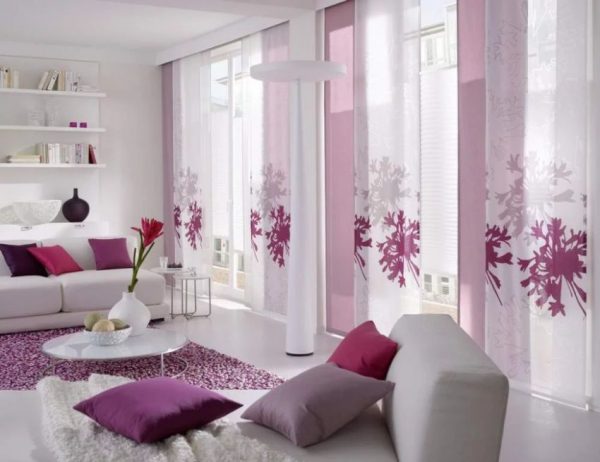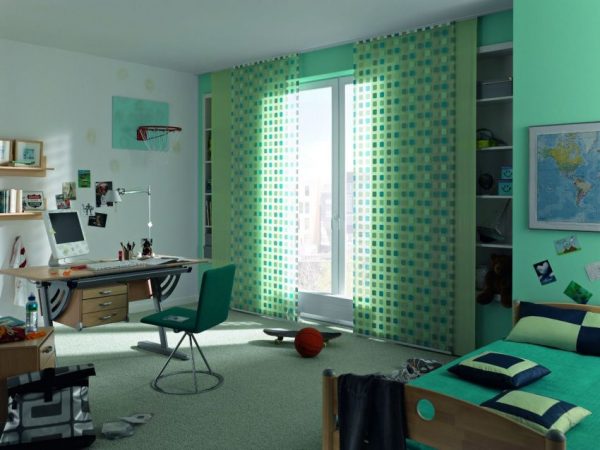Japanese curtains are often called panels. Indeed, they resemble flat vertical stripes of different widths made of dense material. From the Land of the Rising Sun, such curtains spread throughout the world, becoming a fashionable designer detail.
- Appearance History and Features
- Varieties of cornices
- Types of management
- Materials for the manufacture of curtains
- Sizes of curtains
- Advantages and disadvantages of Japanese curtains
- Colors and patterns
- Style solutions
- Ethnic style
- Minimalism
- Eco style
- Modern style and hi-tech
- Japanese curtains in different rooms
- Living room
- Bedroom
- Kitchen
- Loggia and balcony
- Children
- Office
- Custom Product Usage
- How to make Japanese curtains with your own hands?
- Japanese Curtain Care

Appearance History and Features
Japanese (screen) curtains are fabric panels that move along the ledge on the carriage. The principle of operation of the curtains resembles the work of a sliding wardrobe. To prevent the panels from deforming and folding, rigid inserts are provided at the top and bottom of the structure. There are no bows, lambrequins, laces on such blinds, so their appearance may seem rather strict and modest. Curtains can serve as curtains, doors, partitions and screens.
Japanese curtains come from Japan. They began to be used in the 13th century as room dividers, although at that time they had a completely different look. Now the technology of creating panels has been significantly improved, and their “appearance” has changed.
They are beautiful straight strips of fabric with a width of 50-60 cm. These vertical elements cover the window completely, at least to the window sill. The most stylish panels look on large or panoramic window openings.
Curtains from Japan immediately attract attention. They give the atmosphere subtle oriental notes, enchant and provide a certain mystery. Screen panels are used in houses, apartments, suburban housing, in offices, hotels and restaurants. Harmoniousness and conciseness in such textiles are combined with comfort and beauty, so Japanese curtains are very popular in interior design.
to contents ↑
Varieties of cornices
To place the blinds, it is recommended to use a special eaves with several rows of tires. The maximum number of rows is 5, but in standard designs there are usually fewer stripes. For wide or panoramic windows, curtain rods are made to order. Fabric panels are fixed on each strip, given the style, design.
Cornices are made of plastic or acrylic - practical and inexpensive materials. Also, the products may be metal. There are such types of cornices:
- Tire - mounted on a wall or ceiling, have grooves-strips for the movement of curtains;
- tubular - represent a hollow pipe on which rings or fabric loops for blinds sit.
Types of management
Japanese curtains can have various control options. The most popular type is manual. When the control panel moves, other canvases also shift, although you can change the position of each curtain separately. A variety of manual control is rod. In this case, the curtains need to be moved with a special rod.
With the cord type of control, the panels move by means of a rope, cord. The most expensive is electronic control. In this case, the user has a remote control with buttons that regulate the movement of the curtains.
to contents ↑Materials for the manufacture of curtains
The density of the curtains will depend on how well they protect the room from sunlight in the closed position. Thick fabrics create an atmosphere of twilight, transparent scatter light, contribute to its uniform distribution. Many manufacturers prefer to make Japanese panels of natural material with a variety of textures, colors. Synthetic fabrics are also suitable for the manufacture of curtains. Artificial materials are much cheaper than natural ones.
The most popular fabrics for the production of Japanese curtains are:
- Cotton and linen. These materials are suitable for any curtains - traditional and Japanese. They are 100% environmentally friendly, hardly attract dust, and are breathable.
- Silk. In Japan, the material is often used to make curtains. The price of natural silk is very high, but modern artificial materials also look luxurious.
- Organza. This fabric is very thin, transparent, therefore, they are used for individual inserts in canvases or combined with denser stripes of matter.
- Textured mixed textiles. It has a high density, is decorated with bright protruding drawings, ornament. Such a fabric is often used to create beautiful paintings on the window.
In addition to fabrics, rice paper can be used to make screen curtains. It transmits light well, and from the street makes the window completely protected. Exotic connoisseurs also get bamboo panels. They are beautiful and completely safe for health. Other interesting materials are jute, straw, sisal, which will make screen curtains a fashionable design detail.
You can create an original composition from curtains. To do this, hang products of different colors and textures. You must first choose the right combination of materials.
to contents ↑Sizes of curtains
You can order any curtains from the master, after making measurements of the window. In size, they can be as follows:
- Long (to the floor). They can serve as decor for windows, as “doors” for openings, niches, cabinets. If necessary, used as a wall covering.
- Short. Usually they are translucent, more often monochromatic. They have a small length - only to the windowsill. Ideal for small windows. Visually expand the space.
Advantages and disadvantages of Japanese curtains
Curtains of this type occupy a minimum of space, look easy, airy. They are suitable for large and small rooms. Other advantages of Japanese curtains:
- canvases collect less dust than traditional curtains and draperies, because they have no folds;
- cleaning curtains is very simple, and standard household chemicals are suitable for most fabrics;
- the range of colors is huge;
- Japanese panels are suitable for all windows: large, small, panoramic, balcony;
- the price of products is low, and the consumption of fabric is minimal;
- curtains save space in the room, are ergonomic.
There are almost no drawbacks to Japanese curtains. The only thing that does not please is the limited form (rectangular or square).
to contents ↑Colors and patterns
The following are the most popular colors used by decorators:
- Gray. It looks stylish, but it may seem dull and too conservative. It is worthwhile to choose other, lighter and more interesting tones to it.
- Brown. It is considered neutral, does not dominate the interior. It is "natural", elegant. Suitable for different styles.
- White. Refreshes the room, gives it a festive look. Ideal for the manufacture of curtains.
- Green. Inspires thoughts of summer, nature. Improves mood, tunes to positive.
- The black. Luxurious color. It is usually applied together with white, beige, other light shade. Otherwise, the room will be dark.
- Pink. Tones up, draws attention to itself. Well suited for a romantic setting.
- Purple. It catches the eye, is very beautiful and deep.Great for making Japanese panels.
- Beige. The base color that designers consider stylish and sophisticated. Provides the room with homely warmth and comfort.
Panels for windows can be plain. Usually they are used in the design of a bedroom, cabinet. A popular pattern on the curtains is various floral motifs. In Japan, these are sakura flowers, orchids.
They attract eyes and visually smooth out the imperfections of the room. Japanese cherry makes the room bright but tender. It looks especially good against the background of beige, light gray and white walls. Curtains with geometric patterns are well suited for the kitchen, living room, study, bedroom. Usually they are used in modern, minimalism. Such drawings make the room concise and austere.
Openwork curtains - an exquisite way to decorate the bedroom. Thin carved patterns on textiles will make the room romantic. Curtains with a transparent middle and dense sides are a good solution for rooms where there is no bright sunlight. They are unusually fashionable and elegant.
to contents ↑Style solutions
Designers almost always recommend window paneling if the chosen style is Japanese minimalism. In combination with mats, wood and stone, they will serve as the “calling card” of this style. No less well, such curtains will fit into other types of design, based on simplicity, functionality and conciseness.
Ethnic style
For ethno, it is worth choosing curtains with bright patterns and interesting decor. It is better to give preference to natural fabrics with a slightly rough structure (for example, flax). If an oriental style is chosen, the interior can be additionally decorated with mats, and screens can be made of Japanese panels.
to contents ↑Minimalism
When decorating an apartment, you need to take into account the rule: "a minimum of interior and decor, a maximum of light and space." Modest panel curtains are perfect for minimalism. They should be monophonic, made in a modest color scheme.
Eco style
Modest and simple curtains from jute, rice paper, other natural materials will perfectly fit into such a design. Heavy, expensive fabrics in an eco-direction are not used.
Modern style and hi-tech
Common features of modern design trends are conciseness, clear lines, and an abundance of geometry. The absence of folds, ruffles and draperies makes Japanese panels suitable for such interiors. The fabric here can be combined with metal and wooden cornices, as well as with leather inserts.
to contents ↑Japanese curtains in different rooms
Depending on the type of room, there are some features of the inclusion of Japanese panels in the interior.
Living room
The living room is most often the largest room in the apartment. The shade for Japanese paintings in this room is selected for the rest of the decor. Contrast curtains look better with tulle or regular curtains. It is important that the fabrics retain their shape after washing. For curtains in the living room, such materials are well suited:
- taffeta;
- organza;
- moire;
- satin;
- silk;
- reaper;
- veil;
- linen.
At the peak of popularity among drawings on textiles are Japanese characters, animals and birds, city landscapes. You can also use geometry, abstraction, floral motifs or adopt the technique of alternating panels between color and plain options.
to contents ↑Bedroom
In the bedroom, it is recommended to use curtains in pastel colors without a flashy decor. This will help to maintain the atmosphere of bliss, relaxation and tranquility in the room. Delicate colors of finishes will set you up for a romantic mood, improve your mood. It is acceptable to choose fabrics with an unobtrusive graphic or floral pattern: linen, cotton, silk.Also for the bedroom, soft stripes, geometry or abstraction are suitable.
to contents ↑Kitchen
For the kitchen, often choose short curtains, which is due to practical benefits - they are less dirty, do not interfere in the process of walking and cooking. If the design style allows, it is worth choosing easy-to-clean materials: bamboo, straws, jute. For the kitchen, light, natural shades are more suitable: green, brown, the colors of the sky and fallen leaves. Bright spots in this room are not welcome, especially if it is combined with the dining room.
to contents ↑Loggia and balcony
Japanese curtains are perfect for shading balcony windows. Every centimeter of space is expensive here, so the panels should be compact, preferably up to the windowsill. Only on large loggias with panoramic windows, long screen curtains to the floor look appropriate. To reduce the intensity of sunlight, it is worth choosing dense, durable fabrics for curtains that do not shine through and do not fade.
to contents ↑Children
Light curtains are often used in children's rooms. A suitable decor would be the image of fairy-tale characters, cartoon characters, books. Also, children love pictures with animals, plants, tropical and underwater world.
to contents ↑Office
High-quality and beautiful curtains are used in offices, salons and shops. It is better to use expensive, refined fabrics to add luxury to the interior and enhance status. The company logos look interesting as a decor for the fabric.
to contents ↑Custom Product Usage
Japanese curtains can be used instead of partitions. They help to zone the space: divide the kitchen and dining room, bathroom and bathroom into independent sections. Also, curtains can be used instead of cabinet doors to save space. This is especially true in a small bedroom or hallway.
How to make Japanese curtains with your own hands?
For the manufacture of curtains, you need to purchase the selected fabric and curtain rod, and then act in this way:
- Calculate the right amount of fabric, given the width of one panel (usually 60 cm) and its length (from the cornice to the floor). Also, allowances for seams should be added - 3 cm on each side.
- Cut the fabric into strips. It is good to smooth out each cut.
- Run side seams. If the fabric is thin, insert frame slats into them.
- Hem the bottom edge as a drawstring, insert a weighting tape into it.
- Sew Velcro to the top of the curtain, previously securing it with pins in the desired position.
- Hang the finished product on the ledge.
to contents ↑
Japanese Curtain Care
Fabrics can be washed in the usual way, in the car, but in a delicate mode. Before washing, remove the ties and weighting materials so as not to damage them. Bamboo, jute curtains are brushed, vacuum cleaned with a damp sponge. Perhaps the use of a soap solution.
The popularity of Japanese curtains is constantly growing. They are beautiful, functional and durable as well as inexpensive. This allows you to use products in different types of interior homes, apartments and offices.






















